Dark Fear is a horror-themed adventure game with some light RPG mechanics which puts its best foot forward. While it has some jumpscares, the focus is less on scaring the player and more on exploring the strange and haunted lands the amnesiac protagonist finds himself in. The game definitely stumbles in its final act, but the journey makes up for the shortcomings which crop up near the end.
Taken individually, the various gameplay elements found in Dark Fear are rather basic, but together they make for a pleasantly unusual combination. On the adventure game side of things, there are plenty of items in the environment to pick up or otherwise interact with, certain inventory items can be combined, and puzzles are puzzles are split between using items in specific locations or more specific challenges, such as arranging blocks to spell a word. There are also a few interactions which are more tactile in nature, such as collecting lights to ‘awaken’ at the start or moving the mouse back and forth to pick a lock, and these likely feel a bit more at home in the mobile version of this game, but they still work fine in the PC version and help to add another layer of variety. Pixel hunting is thankfully not an issue here as, with the minor exception of a stick in an early area, objects which can be collected or examined are easy to see and the cursor even changes when hovering over points of interest. Item uses and combinations consistently make sense and are often intuitive. If an item has an usual use, there is inevitably either a clear hint either within the environment or in the item’s own description when it is examined from the inventory.
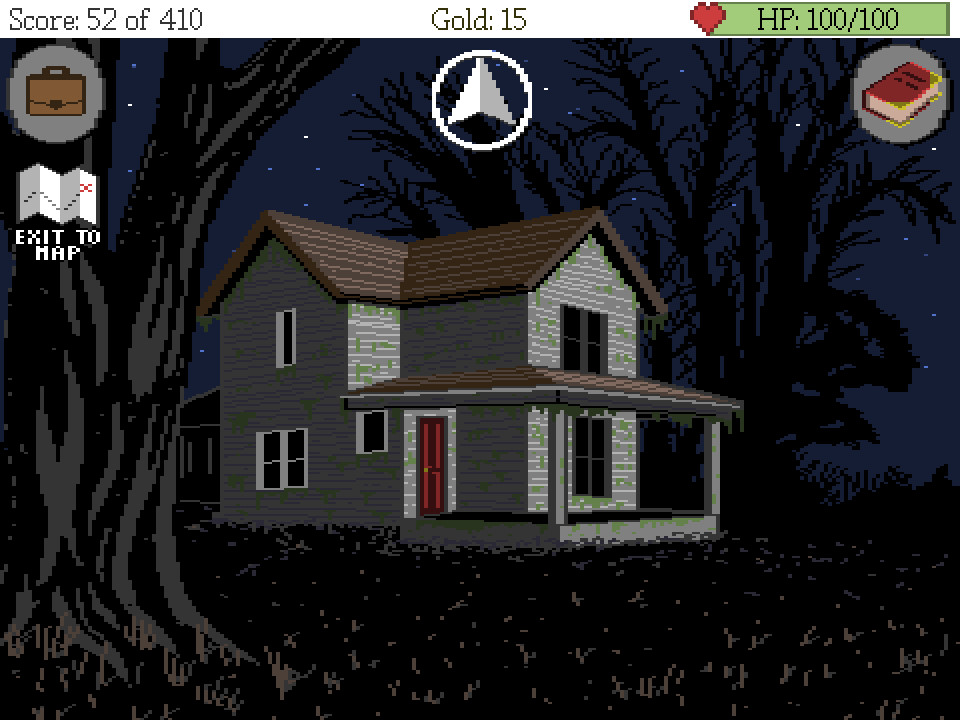
The RPG elements are the parts which are primarily responsible for the issues which crop up in the final stretch of the game, which we’ll be taking a look at later, but for now we’ll be discussing just what they are and how they affect the game in a positive way. The three main types of RPG content are combat, shopping, and gathering. Combat is turn-based and always one-on-one, though weaker enemies sometimes come in waves. There are only four commands in combat: Potion consumes a healing potion, Defend has a 50% chance to work and results in the enemy missing with their next two attacks and is almost never worth actually using, Flee is a guaranteed escape where the only penalty is any gold found from defeating enemies in a set isn’t kept, and Attack. When Attack is chosen a bar appears near the bottom with a sliding arrow and clicking when the arrow is near the center of the bar will deal 100% damage while damage decreases if the arrow is farther away from the center and becomes a complete miss at the far ends.
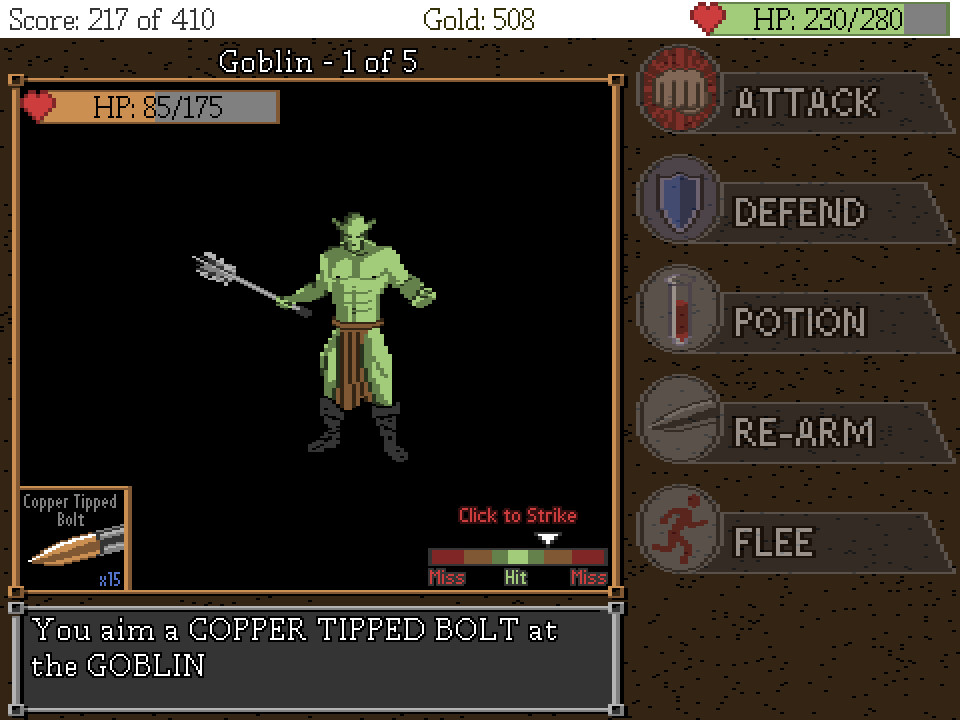
Shopping consists of linear weapon and armor upgrades as well as tattoos and potions. Armor boosts the player’s maximum health and, after the first few weapons, the crossbow becomes available and weapon upgrades come in the form of consumable crossbow bolts, which, with two exceptions, consist of increasingly stronger standard bolts and ‘special’ bolts which are only useful against specific enemies and require two normal attacks to charge up. Potions can be useful early on, but even the best potions just aren’t worth using against later enemies, which often hit for well over half as much as even the best potion can heal. Meanwhile, tattoos will ‘seal’ the special ability of a boss; there is a slight puzzle element to figuring out which seal goes with which boss based on the design of each tattoo and it’s likely impossible to kill any given boss without the proper tattoo, but the fact that only one tattoo can be equipped at a time and money needs to be paid to change tattoos every time makes the system more of a hassle than anything else. As for gathering, certain areas allow you to go hunting or fishing where some basic quick time events allow you to gather animal pelts or fish; fish can only be sold for money while pelts are used both for gaining money and for crafting better armor.

Both the adventure elements and the RPG elements of Dark Fear are rather easy, one of the ‘puzzles’ is literally nothing more than a simple math equation, and the horror elements outside of the jumpscares mostly make for a fun setting rather than actually being scary, but the game has a great sense of pacing. The overarching plot may revolve around the protagonist trying to find out who he is and why he has been mysteriously transported to this rather haunted region, but for the most part the game is made up of a series of vignettes. You’ll hear about a problem or a rumor from an NPC in town, go to the world map to travel to a newly unlocked location and possibly get attacked on your first trip or get attacked upon arriving, poke around the new area to find items which may or may not get used right away, and solve a few puzzles before encountering a boss (possibly alongside a jumpscare) and then new upgrades will unlock in town and the cycle can be repeated. Individual areas tend to be small with most consisting of no more than two or three screens, but sometimes you’ll need to move between a set of areas to complete a task and near the middle of the game you have some freedom in deciding the order in which you complete objectives. It’s an all-around solid gameplay loop which flows well and the variety of activities within the game alongside the wide variety in types of locations ensures that it remains entertaining.
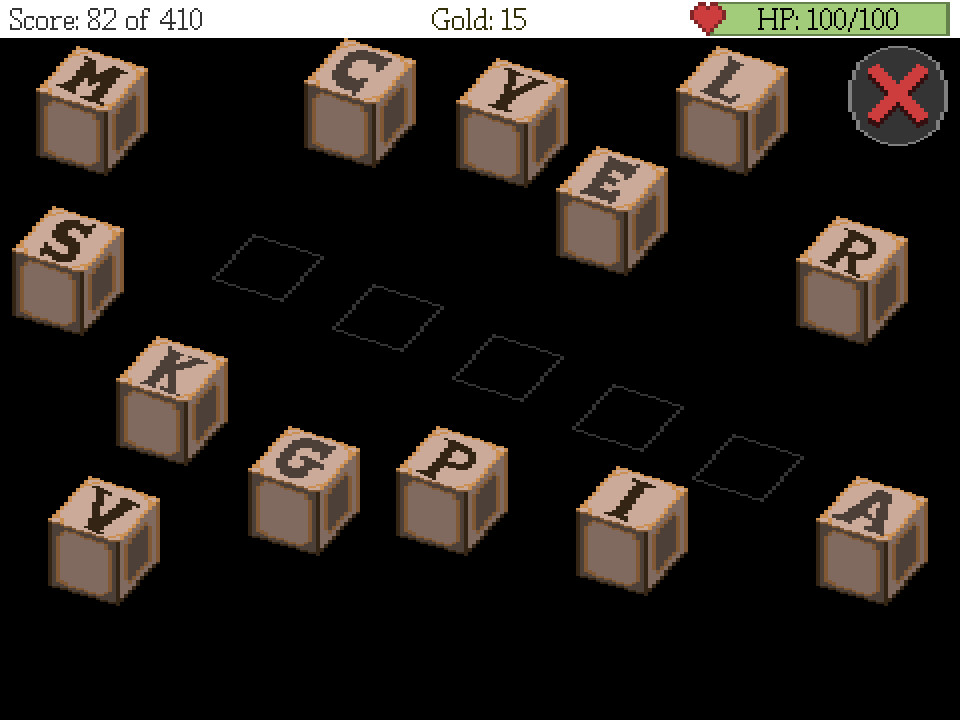
However, the game is at its best during its two haunted house areas. Each of these areas is much bigger than the other regions, consisting of multiple screens outside the house and several inside. These areas also feel more legitimately creepy than the other regions with dark lighting, worn or broken furniture, and an all-around tense atmosphere. Puzzles in these houses aren’t any more difficult than in the rest of the game, but they are nicely contained with clues in one room being required to find the solutions to puzzles elsewhere in each house. Last but not least, these houses have a greater sense of importance to them as in each case an NPC will give you some fairly extensive pieces of backstory on the house and its inhuman inhabitant while also warning you that you must be completely prepared for what is to come; nearly every fight in the game is balanced to result in the player surviving one hit away from death if they have all the best gear available and have consistently hit with 100% power so the boss fights here aren’t actually any harder than anywhere else, but they have the feeling of a proper showdown.
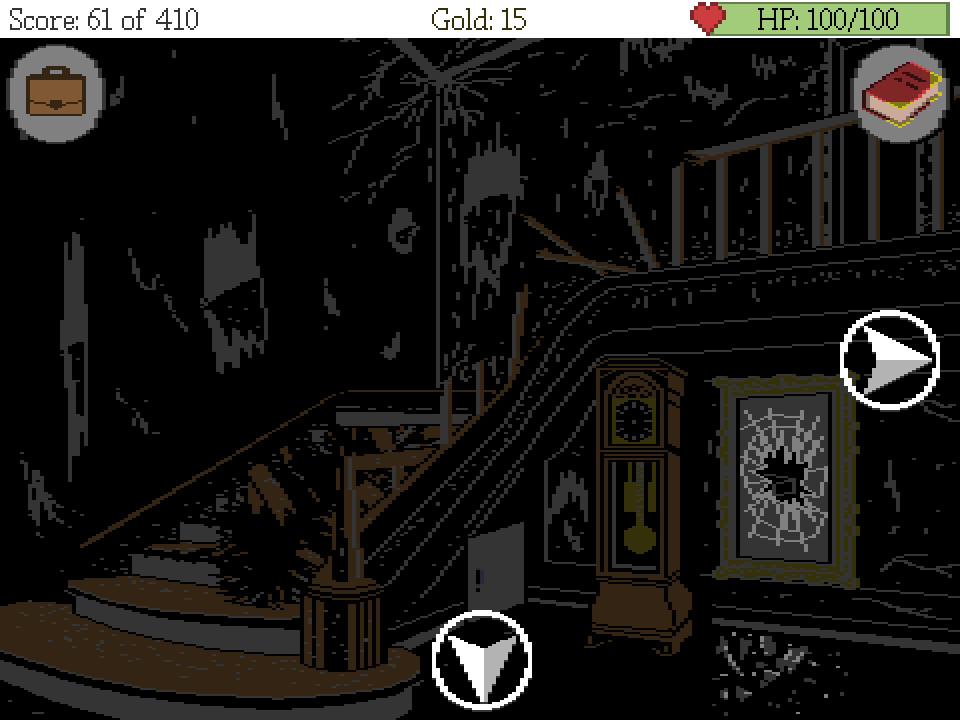
Unfortunately, it is time to talk about the content which makes up roughly the final third of the game. I’m not going to try to sugarcoat this – it feels rushed, it feels sloppy, and it’s unenjoyable enough that it made be seriously consider not recommending this game despite how much I really do enjoy the rest of it. The vinette style to the storytelling largely disappears at this point as the focus is shifted at last to the protagonist’s own plot in two massive bursts of exposition which feel convoluted, somewhat nonsensical, and outright contradictory alongside a twist at the end which is both ridiculous and utterly pointless. The focus is also firmly shifted away from the adventure game elements at this point as puzzles virtually vanish without a trace and the gameplay loop becomes one of traveling to an area, fighting a boss on the first or some screen, picking up a plot item which the boss dropped or was guarding, and then taking the item to an NPC who will proceed to tell you where to go next. Jumpscares are nonexistent at this point and even the occasional encounters against enemies on your first trip to a new location or against waves of weaker enemies on the first screen seem to vanish without a trace. The result is an odd sort of boss rush in a game where every fight consists of repeatedly shooting two bolts followed by a strong special bolt until the boss dies and running away to conserve ammo if you don’t hit 100% on one of the special attacks.
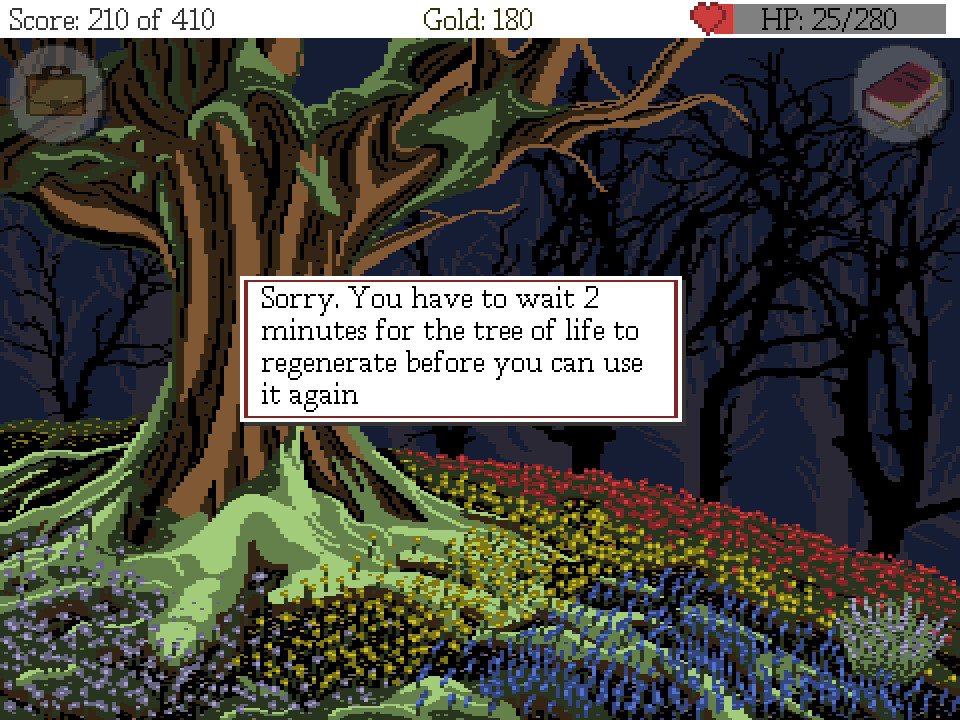
More than the poor storytelling and the almost complete removal of the adventure game parts of this adventure game, the greatest fault of this final stretch is that it is astonishingly tedious. It’s hard to judge just how much of the game this portion represents; according to the in-game point tracker it’s around a quarter of the content at most, but the amount of mandatory grinding you have to do makes to stretch out to take up a huge amount of time. Yes, this section is all about the grind as before each and every fight you must buy the appropriate tattoo, buy the next tier of armor, and buy somewhere between six to ten of the best normal bolts and three to five of the special bolts which the current boss is weak against. This isn’t just to make the fights easier either – it’s mandatory for survival; special abilities range from immediately killing the protagonist to fully healing the boss if they aren’t sealed, the special bolts deal thousands more damage than even the best regular bolts, and the health bonuses from armor get increasingly massive while even the best potions available soon become worthless. Sure, you get some money from killing each boss, but it’s certainly not enough to buy the necessary tattoo, bolts, and armor on its own and the lack of any other fights means that you’ll need to get the rest of the money from hunting and fishing.
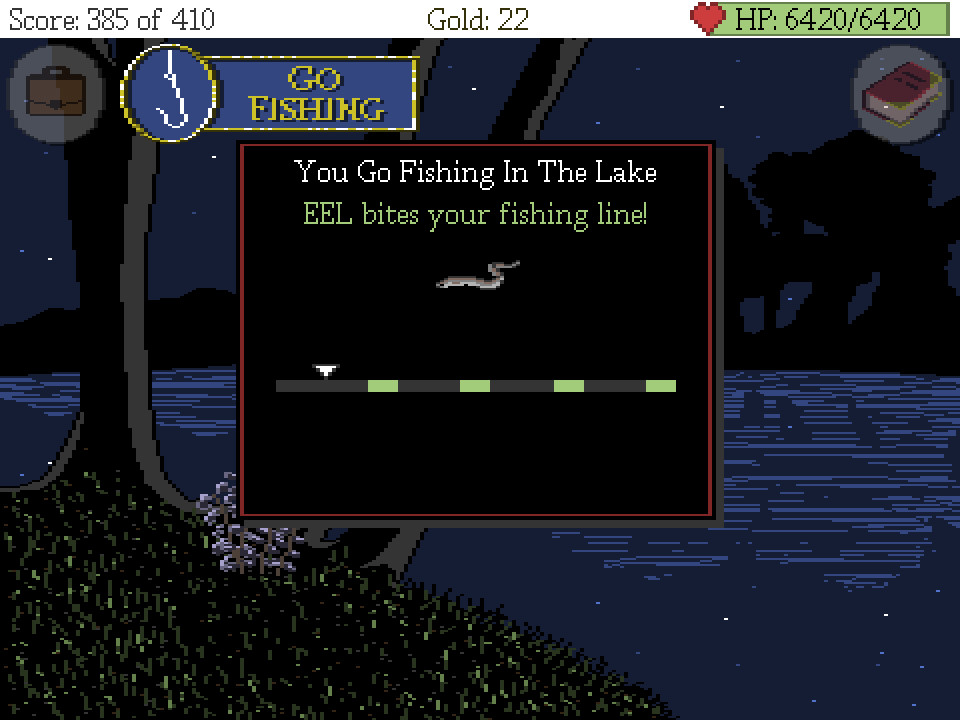
Pelts and fish each only take a few seconds to get, but even the most valuable of the lot only sell for slightly more than 30 gold. For comparison, the most expensive tattoo costs 320 gold, the most expensive special bolts cost 150 gold per bolt, and all of the later armor upgrades cost several thousand gold each on top of requiring specific rare pelts from various regions to craft. Despite the lack of a Game Over state, it becomes nearly mandatory to save frequently as bringing the wrong tattoo to a fight, bringing too few of the required special bolt, or hitting for less than 100% power more than once or twice with a normal bolt will result in the fight being lost and needing to gather even more pelts and fish to replace the bolts consumed during the fight. At least there is a way to instantly restore your health to full after each fight; it technically has a cooldown of about two minutes, but realistically you’ll need to spend far more time than that gathering supplies between fights anyway. Gathering is fine in the early parts of the game as just one more brief type of activity mixed in amongst plenty of other activities and combat serves to complement the storytelling, but the combat is far too shallow to hold up on its own and a part of the game which would have otherwise taken up no more than a few minutes is agonizingly stretched out to well over an hour of miserable tedium by just how much money needs to be earned bit by bit through hunting and fishing. This all may sound like some rather harsh criticism for a game which I am still ultimately recommending, but the final act really is a significant departure from the pace and overall feel of the rest of the game.
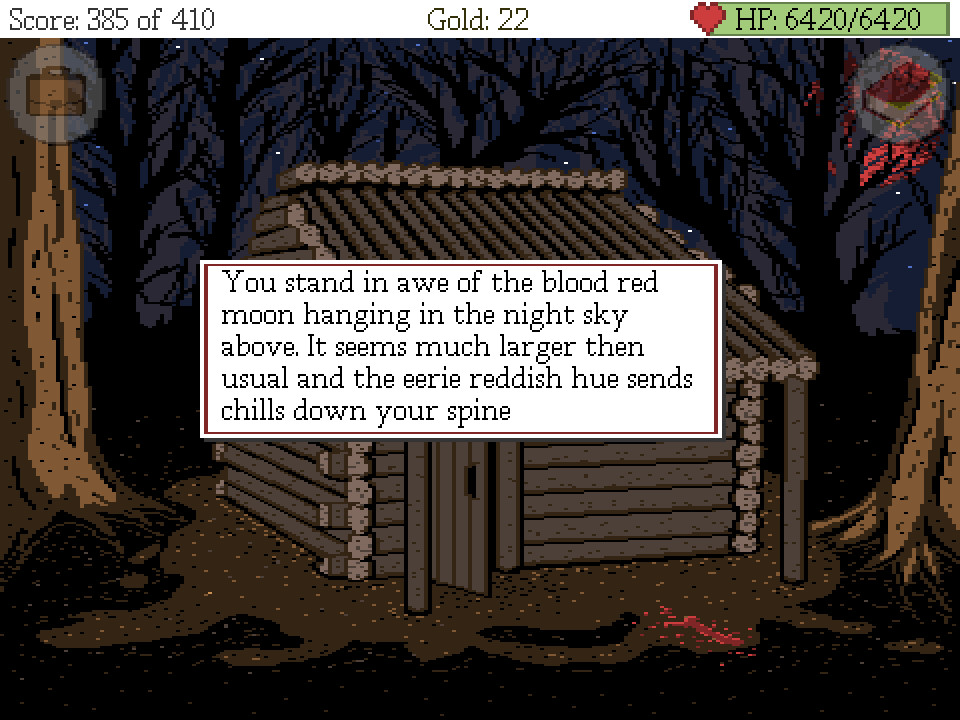
In the end, Dark Fear feels like two very different games. The first is an easy yet enjoyable point-and-click adventure game in a neat setting with a few brief, simplistic activities like combat and resource gathering to spice things up and make it really stand out from the crowd. the other game is a gauntlet of completely shallow and arbitrary boss fights separated by little other than occasional gobs of exposition and hundreds of boring quick time events to gather gold and crafting resources. I definitely recommend the game which Dark Fear is for the majority of its duration, but this comes with the warning that you’ll eventually have to slog through the game which it becomes if you want to see it through to the end.